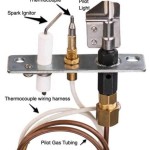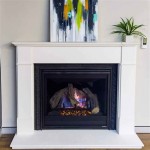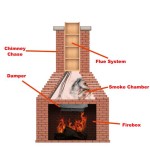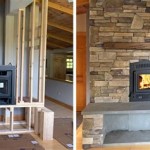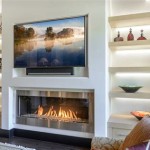Understanding the Fireplace Throat Damper
The fireplace throat damper is a crucial component in a traditional masonry fireplace system. Its primary function is to regulate airflow, preventing heat loss from the house when the fireplace is not in use and facilitating the efficient venting of smoke and combustion byproducts during operation. A well-functioning damper significantly contributes to energy efficiency and indoor air quality.
Located directly above the firebox, the throat damper sits within the smoke chamber, just below the flue. This positioning allows it to effectively seal off the chimney when closed, minimizing the escape of heated or cooled air from the home. Conversely, when open, it provides a clear pathway for smoke to rise and exit through the chimney, preventing it from entering the living space.
Historically, throat dampers were constructed of cast iron due to its durability and resistance to high temperatures. However, newer designs may incorporate other materials like stainless steel. The design generally consists of a hinged metal plate that pivots to open or close the flue opening. Operation is typically controlled by a lever or handle located within the firebox or just above it. This handle allows the user to easily adjust the damper position.
The effectiveness of a throat damper hinges on its ability to create a tight seal when closed. Over time, however, dampers can become warped, rusted, or otherwise damaged, leading to air leaks and decreased efficiency. Regular inspection and maintenance are therefore essential to ensure optimal performance.
Key Point 1: Functionality and Purpose
The primary function of the fireplace throat damper is twofold: to prevent heat loss up the chimney when the fireplace is not in use and to control airflow during a fire, ensuring proper venting. When closed, the damper acts as a barrier, preventing warm air in the winter and cool air in the summer from escaping through the chimney. This significantly reduces energy waste and lowers heating and cooling costs. Studies have shown that an open damper can lead to substantial heat loss, equivalent to leaving a window open throughout the heating season.
During a fire, the damper must be fully opened to allow for proper ventilation. This ensures that smoke, carbon monoxide, and other harmful byproducts of combustion are directed up the chimney and away from the living space. Insufficient ventilation can lead to smoke backdrafting, causing unpleasant odors, respiratory irritation, and even carbon monoxide poisoning. The proper opening of the damper, in conjunction with a well-designed chimney and flue, is essential for a safe and enjoyable fireplace experience.
The size of the damper opening can also be adjusted to control the draft. A strong draft can cause a fire to burn too quickly, while a weak draft can lead to smoking problems. Adjusting the damper allows for a more controlled and efficient burn, maximizing heat output and minimizing smoke production. Factors such as chimney height, wind conditions, and the type of wood being burned all influence the optimal damper setting.
The damper's role extends beyond simply opening and closing; it is a fine-tuning mechanism that allows the user to manage the fireplace's performance. Understanding its function and how to operate it correctly is crucial for both energy efficiency and safety.
Key Point 2: Common Problems and Solutions
Several issues can compromise the functionality of a fireplace throat damper. One of the most common problems is rust. Over time, moisture and condensation can corrode the metal, causing it to weaken and eventually seize. Rust can also prevent the damper from forming a tight seal, leading to air leaks. Regular cleaning and lubrication can help prevent rust, but severely corroded dampers may need to be replaced.
Another frequent problem is warping. Exposure to high temperatures can cause the metal to bend and distort, preventing the damper from closing properly. Warping is often caused by overheating the fireplace or burning excessively large fires. While minor warping can sometimes be corrected by manually bending the damper back into shape, significant warping requires replacement.
The damper handle and linkage can also become stiff or broken. This can make it difficult or impossible to open and close the damper. Lubricating the moving parts can often resolve stiffness, but a broken handle or linkage will need to be repaired or replaced. This type of repair is often best left to a qualified professional.
Debris, such as leaves, twigs, and animal nests, can also accumulate in the smoke chamber and around the damper, obstructing its movement and preventing a proper seal. Regular chimney sweeping and inspection can help prevent debris buildup. If debris is present, it should be carefully removed to ensure the damper can operate freely.
Finally, improper installation can lead to problems. If the damper is not correctly sized or positioned, it may not seal properly or may interfere with the draft. A qualified professional should always install or replace a fireplace damper to ensure proper fit and function.
Key Point 3: Maintenance and Replacement
Regular maintenance is essential to prolong the lifespan and ensure the proper function of a fireplace throat damper. A visual inspection should be conducted at least once a year, preferably before the heating season begins. This inspection should include checking for rust, warping, cracks, and debris buildup. The operation of the damper handle and linkage should also be tested to ensure smooth movement.
Cleaning is an important part of maintenance. The damper should be cleaned regularly to remove soot, creosote, and other deposits that can accumulate over time. A wire brush or scraper can be used to remove stubborn deposits. Care should be taken not to damage the damper during cleaning. The smoke chamber should also be cleaned to remove any debris that may be obstructing the damper's movement.
Lubrication can help prevent rust and ensure smooth operation. The damper handle and linkage should be lubricated with a heat-resistant lubricant at least once a year. This will help prevent stiffness and ensure that the damper opens and closes easily. The hinge points of the damper itself can also be lubricated.
If the damper is severely rusted, warped, or otherwise damaged, replacement may be necessary. When replacing a damper, it is important to choose a replacement that is the correct size and type for the fireplace. Measuring the existing damper and smoke chamber will help ensure a proper fit. A qualified professional should install the replacement damper to ensure proper function and safety.
Alternatives to traditional throat dampers exist, such as top-sealing dampers. These dampers mount at the top of the chimney and provide a tighter seal than throat dampers, resulting in greater energy savings. However, they also have their own set of maintenance requirements and may not be suitable for all fireplaces. Proper maintenance and timely replacement of a fireplace throat damper are crucial for ensuring energy efficiency, safety, and the longevity of the fireplace system.
The selection of the correct replacement damper is also critical. Factors to consider include the material of construction (cast iron or stainless steel), the method of operation (lever or poker control), and the presence of any special features, such as a built-in smoke shelf. Consulting with a qualified professional can help ensure that the replacement damper is the best fit for the specific fireplace.
In summary, the fireplace throat damper is a vital component that requires regular attention to function safely and efficiently. Understanding its purpose, recognizing potential problems, and implementing a proper maintenance schedule are all essential for maximizing its benefits and ensuring a safe and enjoyable fireplace experience.

Top Mount Vs Throat Dampers Fireplace Damper Portland Oregon

Do You Have A Top Mount Damper Or Throat For Your Chimney

Stop Losing Heat Up Your Fireplace Chimney Ohmefficient

Nicholas Chimney Sweeping Stove Fireplace Services Vienna Virginia

Fireplace Damper Repair Full Service Chimney Kansas City

Types Of Diffe Chimney Dampers Severna Park Pasadena Md

Fireplace Damper Repair Top Mount Chimney Installation

Don T Let A Leaky Chimney Damper Dampen Your Spring American Masonry

What Is A Chimney Damper Why It Important

Fireplace Dampers The Blog At Fireplacemall
Related Posts

